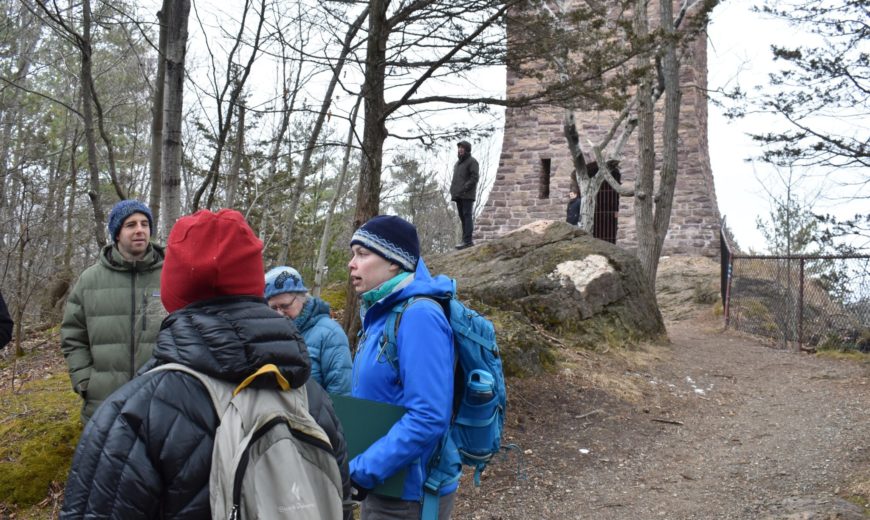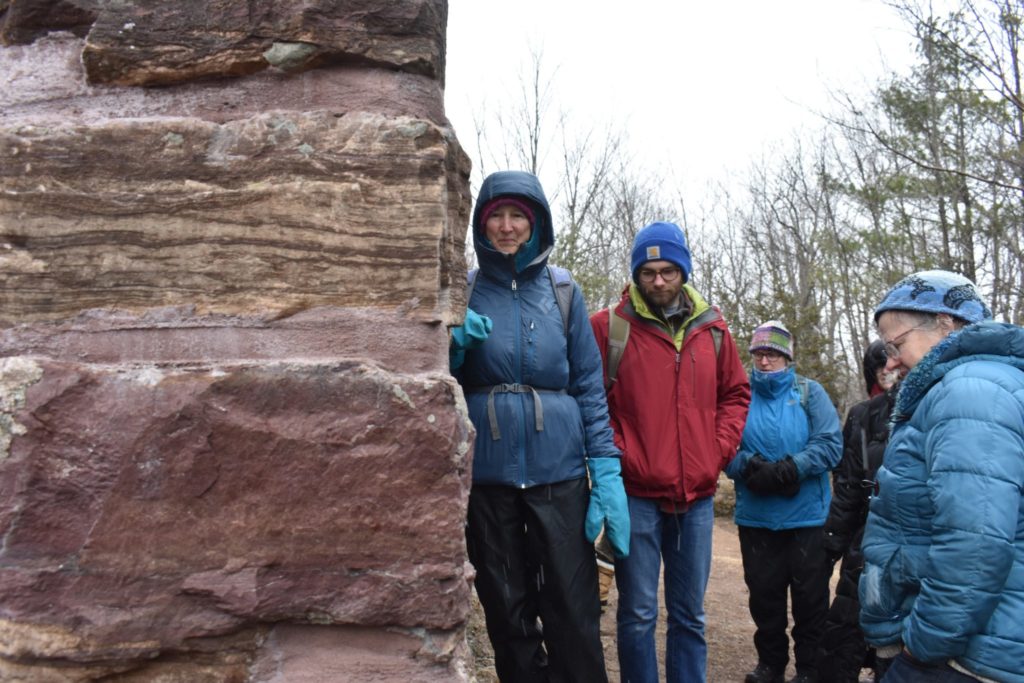A Brief History of Settlement

Written by Gabe Allen.
On Sunday, March 4th the 2017-2018 Vermont Master Naturalist BTV candidates gathered for the fourth and penultimate time at Ethan Allen Park. Canada Geese flew overhead through sparse wet snow. The forecast could have deterred a less intrepid group, but talk among the aspiring naturalists was of their excitement for winter tree identification and tracking opportunities. After introductions, we walked up a new VYCC trail to the Ethan Allen tower, a formidable monument that overlooks the New North End of Burlington. Sam Ford, a Historic Preservationist, Charlotte native, and UVM alum, led the morning session on the human history of Burlington and, in particular, Ethan Allen Park.
She started the discussion with a riddle: what is the place that all parks and green spaces grew from? A place with many people but no one living. The answer: the cemetery. Before parks and “urban wilds” were around, people would make frequent visits to cemeteries where their relatives were buried. These visits occupied a similar place for catharsis and relaxation in our ancestor’s lives as a walk in the park provides to Burlingtonians today. Sam explained that many early parks were designed with a “cemetary ethic,” where the landscape was highly manipulated and manicured and flora was largely imported and intentionally arranged (Central Park in Manhattan is an example).
Ethan Allen Park, established in 1905 as a tribute to the leader of the Green Mountain Boys, employs a different ethic. Here natural features are highlighted and materials were sourced locally. The Ethan Allen tower stands on “Indian Rock,” a high point in the North End that was employed by the Abenaki and later the Green Mountain Boys to spot incoming boats on Lake Champlain. The structure is built from a mixture of Dunham Dolostone and Monkton Quartzite, which was quarried nearby from the same fault line that runs along the park. William Van Patten, the original financier and designer of the park, also designed and constructed carriage roads, a gazebo, and walking trails to showcase the natural beauty of the place. The opening ceremony attracted thousands of visitors and, although he didn’t attend, Franklin Roosevelt was on the guest list.
Prompted by Alicia to pay attention to geology, the group noticed that the rock that the tower was made from was slightly different from the surrounding bedrock. We contemplated this as Sam launched into a brief people’s history of Burlington (see the previous Master Naturalist article for the First Nations version).
The first wave of settlement in present day Burlington was in the 1760s in the decade following the French and Indian War. The ensuing decades of war and land disputes meant that, for a long time, Vermont’s population barely grew. For almost a century Vermonters primary occupation was subsistence farming. Then, in the mid 19th century, the woolens industry grew rapidly and Vermont briefly became the largest wool exporter in the world. Soon wool gave way to a burgeoning lumber industry, but by this time Burlington had been established as a center of industry. Van Patten himself was a manufacturing tycoon in Burlington’s South End.
After we imagined Burlington during various stages of agrarianism and industrialization, the group walked back down the trail and, on the way, identified red oak, hophornbeam, white ash, white pine, and shagbark hickory growing out of the calcium-rich soil. Come June, someone mentioned, you might even find an elusive Lady slipper tucked away among the pines and oaks.
The next Burlington green space on our schedule was Arms Forest. Sam told us the story of death and honor that accompanies this land as we regrouped in the Burlington High School Parking lot. The earliest farmers on the land were the Phillip and Esther Manwell, who bought the land from Thaddeus Fletcher, a Burlington philanthropist, in 1868. Decades of untimely deaths befell the Manwell family. In 1918 Esther’s adoptive nephew, Phillip, died during the sinking of the S. S. Tuscania by a German U-boat in the Atlantic leaving the farm with no living heirs. In 1921 Willard Arms bought the land and operated a successful dairy farm on the land for the next 40 years. In the 60’s the land was purchased by the city for the location of the new Burlington High School. Willard Arms, a staunch conservationist, stipulated that the land behind the school be left undeveloped.
We wandered into Arms Forest until we came to a sunken pit filled with blocks of red and grey rock and large white birches. This is the site of the ill-fated Burlington Marble Company, in operation from 1899 to 1925 under a lease from the Manwell family. The “Mallets Bay Marble” that they extracted from the quarry was used to build the neighboring Bishop Hopkins Hall at the Episcopal Diocese, and possibly the Ethan Allen tower as well. Today the dense dolostone blocks are covered in moss, and the pioneer birches that sprouted after the quarry shut down are tall and thick. On our way out we passed by the Bishop Hopkins Hall and wondered about the white cornerstones on the building. Could they have been mined from the same quarry, or are they real marble shipped up from Southern Vermont?
Our last two stops for the day were the Mount Calvary Maple Wetland and Starr Farm. At Mount Calvary, we walked the boardwalks between highbush blueberries and searched for the elusive Black Gum (some of the northernmost individuals of this species reside in this wetland.) On our way out we stared down the outline of an old drainage ditch and imagined the dense greenery of Cinnamon Ferns and tree leaves that would arch over it come spring.
At Starr Farm we paid the flora and fauna uncharacteristically little attention and turned our gaze to the barns on the property. Sam explained that the English style barn, where the doors open outward from the side, was replaced by New England style barns where the doors slide open under the eaves of the roof on the ends of the barn to accommodate for snow accumulation. “If you ever want to place the age of a barn,” she says, “just look at the doors.”
As I drove home from a day of imagining the lives of my ancestral Vermonters, I thought about the clues that we had found throughout the day. The doors on the barn, the color of the rock in the tower, the dominance of birch in the abandoned quarry. History runs deep in Burlington, but it has left traces all around us.

